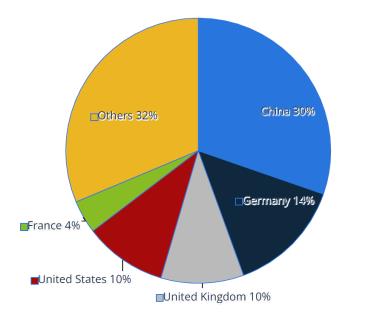

The Why? The Extraordinary e-Commerce Market
(& how FoodNowUS will gain a sizable share...)
(& how FoodNowUS will gain a sizable share...)
Augmented Reality (AR) Market was valued at USD 32.1 Billion in 2022 and is expected to grow from USD 42.85 Billion in 2023 to reach USD 432.35 Billion by 2031, at a CAGR of 33.5% during the forecast period (2024-2031).
Powered by
Augmented Reality
Read More . .
Augmented Reality
Read More . .
" . . .Web technology is indispensable in today's world. It fuels innovation, drives economic growth, enhances education, and transforms communication. Web technology is valuable because it allows businesses and individuals to reach a global audience, share information easily, conduct online transactions, promote brands, and facilitate communication through interactive platforms, enabling access to information on a massive scale; essentially acting as a critical tool for connecting people and businesses worldwide. It allows you to access information from anywhere and at any time from any web ready device. It allows you to access information from anywhere and at any time from any web ready device. . . "
How big is the global B2B (Business to Business) market?
The global B2B eCommerce market was valued at $20.4 trillion in 2022, which is over five (5) times that of the B2C market. The global business-to-business e-commerce market size is estimated to reach $25.65 trillion by 2028, expanding at a CAGR of 18.7% from 2021 to 2028.
https://www.statista.com/study/44442/in-depth-report-b2b-e-commerce/#:~:text=The%20global%20B2B%20eCommerce%20market,trends%2C%20and%20the%20competitive%20landscape.
The global B2B eCommerce market was valued at $20.4 trillion in 2022, which is over five (5) times that of the B2C market. The global business-to-business e-commerce market size is estimated to reach $25.65 trillion by 2028, expanding at a CAGR of 18.7% from 2021 to 2028.
https://www.statista.com/study/44442/in-depth-report-b2b-e-commerce/#:~:text=The%20global%20B2B%20eCommerce%20market,trends%2C%20and%20the%20competitive%20landscape.
The global web development market is currently valued at around $65.35 billion in 2023, with projections to reach approximately $130.9 billion by 2032, demonstrating significant growth potential at a CAGR of 8.03%
Web Development Market:
The e-commerce of agricultural products, is estimated to be around $43.6 billion in 2024 and is projected to reach $90.1 billion by 2033 with a CAGR of 8.4%
How big is the global Farm2Table market? (a subset of the B2C market)
The global food eCommerce market size was $261.88 billion in 2023 and is expected to reach an astounding $1023.66 billion by 2032, at a CAGR of 16.35% during the forecast period.
How big is the global Food eCommerce market?
The global B2C e-commerce market is currently valued at approximately $5.8 trillion in 2023, with projections for significant growth in the coming years, reaching a potential value of around $13.5 trillion by 2032. It is expected to grow at a CAGR of around 11.5% during the forecast period.
The global B2C e-commerce market
Leading markets of most recent cross-border ecommerce purchases worldwide
" . . . According to recent data, US companies are increasingly utilizing Chinese eCommerce platforms, with estimates suggesting that sales from Chinese online platforms in the US could reach around $40 billion in 2024, representing a significant portion of the US eCommerce market. . . "

ref:
According to recent industry calculations, India will rank first among 20 countries worldwide in retail eCommerce development between 2023 and 2027, with a compound annual growth rate of 14.1 percent. Argentina and Brazil are also among the fastest-growing eCommerce markets globally, with a CAGR of over 13.6 percent. The global retail eCommerce CAGR was estimated at 11.16 percent during the same period.
2024 eCommerce market share
China - $3.19 trillion VS United States - $1.22 trillion
Currently, Asia Pacific is leading the way with a B2B market share of almost 78%, leaving North America and Europe far behind
China - $3.19 trillion VS United States - $1.22 trillion
Currently, Asia Pacific is leading the way with a B2B market share of almost 78%, leaving North America and Europe far behind
How big is the global Content Management market?
The global Content Management Software (CMS) Market was worth $28.15 billion in 2023. The market forecast expects to reach $54.16 Billion by 2032, growing at a compound annual growth rate (CAGR) of 7.54% during the 2024-2032 forecast period.
What is the eCommerce software market valued at?
e-commerce software automates business processes by eliminating manual processing errors. The software also provides customers with options to customize delivery dates and times, which enhances customer experience. Companies such as Shopify are integrating Artificial Intelligence (AI) tools to help retailers analyze customer’s buying patterns and estimate the future demand for various products. Owing to these advantages, the number of retailers opting for e-commerce software is bound to rise over the coming years, thereby resulting in market growth.
The increasing adoption of mobile phones for online shopping has led market players such as Shopify to customize their software and operate on these devices. With the high internet penetration rate and the rising number of mobile users, online shopping over these devices is bound to rise. The GSM Association (GSMA) estimates that the internet penetration rate in mobile devices will rise from 48.9% in 2019 to around 60.5% in 2025. Furthermore, the introduction of high-speed internet technology, such as 4G and 5G, is anticipated to impact the growth of the market for e-commerce software positively.
The rising number of e-tailers is also anticipated to generate huge demand for e-commerce software over the forecast period. E-tailers sell their products and services to customers over online platforms and do not need to own or rent a physical store. Their dependency on e-commerce platforms is high as compared to other retailers. However, data security issues due to the increasing cyber-attacks are expected to pose a challenge for the market for e-commerce software. Market players such as 3dcart are focused on offering solutions that have advanced security features to overcome this challenge. The company provides an e-commerce software platform with additional features that reduce the need to install insecure modules and plugins. . . .
Amid the COVID-19 outbreak, governments of various countries have implemented stringent lockdown regulations to prevent the spread of the virus. Shops, malls, and other retail outlets have shut down, which has resulted in bulk buying over online platforms. Limiting shopping of all but life-essential products is becoming a new normal. Retailers are modifying their business strategies accordingly to meet the sudden changes in demand for these products. This factor has a positive impact on the growth of the market for e-commerce software over the long term.
It is expected that the online shopping trend will continue even after the lockdown regulations are removed. Due to this factor, market players are adopting various strategies to expand their customer base. Companies such as BigCommerce Pty. Ltd. and Shopify are currently offering three months of free trial of their e-commerce software to all new merchants. Moreover, Shopify is offering discounts, gift cards, free email marketing plans until October 2020, and online support for all merchants to cater to their requirements effectively.
The e-commerce software industry is expected to witness substantial growth in the coming years. This growth is mainly attributed to the rising number of online stores and online/virtual marketplaces worldwide. In addition, the focus of small businesses and e-commerce companies is shifting towards the adoption of advanced solutions such as e-commerce software. It is mainly to control and manage processes and operations efficiently and effectively. Furthermore, the growing prominence of grocery stores, brick-and-mortar stores, and start-up businesses towards digitization is further supplementing the growth of the market for e-commerce software.
The increasing adoption of mobile phones for online shopping has led market players such as Shopify to customize their software and operate on these devices. With the high internet penetration rate and the rising number of mobile users, online shopping over these devices is bound to rise. The GSM Association (GSMA) estimates that the internet penetration rate in mobile devices will rise from 48.9% in 2019 to around 60.5% in 2025. Furthermore, the introduction of high-speed internet technology, such as 4G and 5G, is anticipated to impact the growth of the market for e-commerce software positively.
The rising number of e-tailers is also anticipated to generate huge demand for e-commerce software over the forecast period. E-tailers sell their products and services to customers over online platforms and do not need to own or rent a physical store. Their dependency on e-commerce platforms is high as compared to other retailers. However, data security issues due to the increasing cyber-attacks are expected to pose a challenge for the market for e-commerce software. Market players such as 3dcart are focused on offering solutions that have advanced security features to overcome this challenge. The company provides an e-commerce software platform with additional features that reduce the need to install insecure modules and plugins. . . .
Amid the COVID-19 outbreak, governments of various countries have implemented stringent lockdown regulations to prevent the spread of the virus. Shops, malls, and other retail outlets have shut down, which has resulted in bulk buying over online platforms. Limiting shopping of all but life-essential products is becoming a new normal. Retailers are modifying their business strategies accordingly to meet the sudden changes in demand for these products. This factor has a positive impact on the growth of the market for e-commerce software over the long term.
It is expected that the online shopping trend will continue even after the lockdown regulations are removed. Due to this factor, market players are adopting various strategies to expand their customer base. Companies such as BigCommerce Pty. Ltd. and Shopify are currently offering three months of free trial of their e-commerce software to all new merchants. Moreover, Shopify is offering discounts, gift cards, free email marketing plans until October 2020, and online support for all merchants to cater to their requirements effectively.
The e-commerce software industry is expected to witness substantial growth in the coming years. This growth is mainly attributed to the rising number of online stores and online/virtual marketplaces worldwide. In addition, the focus of small businesses and e-commerce companies is shifting towards the adoption of advanced solutions such as e-commerce software. It is mainly to control and manage processes and operations efficiently and effectively. Furthermore, the growing prominence of grocery stores, brick-and-mortar stores, and start-up businesses towards digitization is further supplementing the growth of the market for e-commerce software.
Why?

Food2C
(Food to Consumer)
Retail - Food
Online Ordering
Total Value
~$261.88 billion
(Food to Consumer)
Retail - Food
Online Ordering
Total Value
~$261.88 billion

B2C
(Business to Consumer)Retail General
Online Ordering
Total Value:
~$6.3 Trillion
(Business to Consumer)Retail General
Online Ordering
Total Value:
~$6.3 Trillion


B2B
(Business to Business)
Wholesale Market
Supply Chain
Total Value
~$20.4 trillion
(Business to Business)
Wholesale Market
Supply Chain
Total Value
~$20.4 trillion


Web Technology
Total Value
~$65.35 billion
Total Value
~$65.35 billion

Farm-2-Table
Online Ordering
Total Value
$40.2 billion
Online Ordering
Total Value
$40.2 billion
Foonow Inc
Copyright (c) 2025
Copyright (c) 2025
eCommerce
Software
Market
Total Value
~$7.12 billion
CAGR: 15.32%
Software
Market
Total Value
~$7.12 billion
CAGR: 15.32%
Content Management
Total Value
~$28.15 billion
Total Value
~$28.15 billion

See our Farm2Table (C.S.A.) System in action:
We have made "inroads" into this market, including 4 price schedules for various levels wholesale customers, depending on purchase volume. Also, we have advanced inventory solutions for the various colors/sizes/types of products. We have an "upload document" feature for recording Tax IDs etc...
We a;so have a transportation logistics system which can be integrated.
We a;so have a transportation logistics system which can be integrated.
Introducing...
$42.85 - 2023 (8.57)
$57.20 - 2024(11.44) $76.36 - 2025(25.58)
$101.94 - 2026(34.15)
$136.09 - 2027(45.59)
$181.68 - 2028(60.86)
$242.54 - 2029(81.25)
$323.79 - 2030(108.47)
$432.26 - 2031(144.81)
________________
$500 Million +
$57.20 - 2024(11.44) $76.36 - 2025(25.58)
$101.94 - 2026(34.15)
$136.09 - 2027(45.59)
$181.68 - 2028(60.86)
$242.54 - 2029(81.25)
$323.79 - 2030(108.47)
$432.26 - 2031(144.81)
________________
$500 Million +
Estimated A.R. Growth
(Billions):
(Billions):





